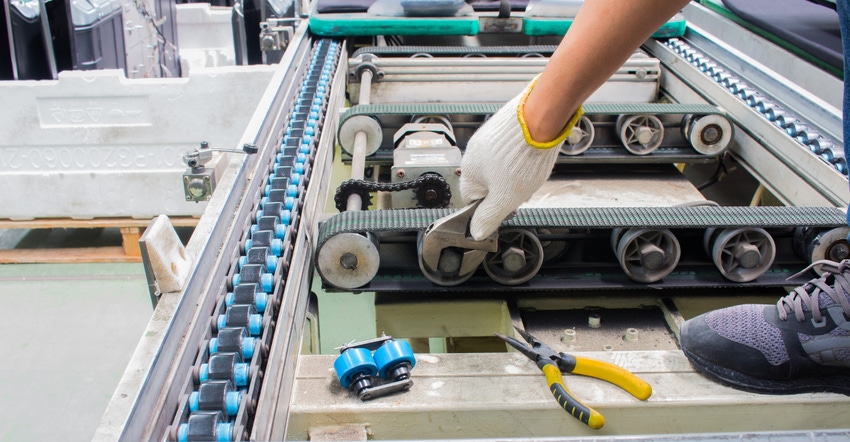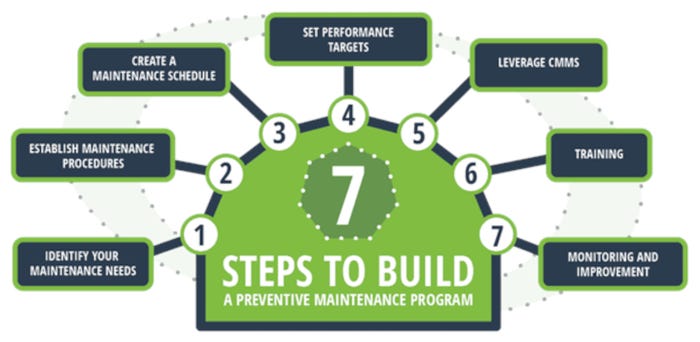Understanding Preventive, Predictive, and Prescriptive Maintenance
Knowing the difference between these three maintenance methods can help you eliminate downtime on your packaging lines and improve productivity.

Preventive, predictive, and prescriptive approaches are all valid ways to streamline packaging equipment management and are a major step up from the “don’t fix it until it breaks” approach.
The consequences for packaging machinery to go down can be more costly for food and beverage manufacturers than other industries. Matura Valley Milk, for instance, risks product spoilage during unplanned downtime, whether labor or machine related. However, using a Computerized Maintenance Management System (CMMS) for well-planned maintenance scheduling and maintenance work, Matura Valley Milk has been able to optimize tasks and actions, improving speed to completion (also known as mean time to repair or MTTR) by up to 35%.
Understanding the different approaches involving preventive, predictive, and prescriptive maintenance — coupled with the power of a CMMS — does more than help you resolve issues and save time. It can help you substantially increase productivity.
Let’s explore these three ways to maintain plant equipment efficiencies and look at the opportunities offered by Computerized Maintenance Management Systems.
Preventive maintenance: Covering the bases.
The main goal behind preventive maintenance (PM) is for the equipment to perform from one planned service to the next without any failures. Regular maintenance when properly matched with a company’s unique maintenance needs in terms of equipment type, criticality, and scale, can help a company avoid expensive repairs, costly replacements, and operational downtime.
For all the intricacies involved in running all the conveyor belts, packaging equipment, and capping machines along the packaging lines, the planning of maintenance in advance can help ensure the required parts are in-house, and appropriate staff time is allocated.
There are seven main steps to consider when implementing a new PM program or improving a current one. First, carefully consider the company’s maintenance needs, develop a comprehensive outline that defines all equipment and maintenance tasks, and set maintenance schedules. From setting program benchmarks, goals, and key performance indicators (KPIs) to leveraging the right supportive technology and training, each foundational step of preventive maintenance ensures the success of the overall program.
A company must first determine the project’s scope and requirements. These considerations are based on the number of machines or equipment that need to be maintained, as well as their age, usage, operating environment, risk to operations, and manufacturer’s recommendations. A program outline can then be created that details the maintenance procedures, maintenance schedules, and required staff.
For example, manufacturers using a preventive maintenance strategy often make use of manufacturer data on a part’s repairs and breakdowns to schedule maintenance before failure occurs. If a particular part within the container cleaning equipment typically fails in four years, the maintenance team may opt to replace it in three years and eleven months, eliminating the potential for unscheduled downtime.
Supported by CMMS software the maintenance program can be tracked and measured over time to determine its success and identify areas for continuous improvement. The CMMS solution should be 100% HTML5 compliant, mobile-friendly, easily adaptable for user acceptance, and provide a complete overview of the company’s assets, including maintenance history, warranty details, and current equipment status.

The limitation of this preventive approach is that it relies on the law of averages. Assuming all assets of the same type are created equally (and that’s not usually the case), you may be replacing a part that might actually have a lot of life left in it.
For example, if specific parts like roller bearings are at the end of their normal lifecycle, replacement is recommended. Alternatively, if a specific part happens to be towards the short-lived end of the normal distribution, it would fail if you waited to replace it based on its average lifespan.
Predictive maintenance: A better approach.
Also strongly supported by CMMS software, predictive maintenance (PdM) is a proactive maintenance approach known for its ability to optimize maintenance and asset management operations, reduce downtime, improve machine performance, reduce costs, and enable data-driven decision-making. It determines the condition of in-service equipment to estimate when maintenance should be performed. This approach promises cost savings over routine or preventive maintenance because tasks are performed only when needed.
Before reaping the benefits, you must successfully integrate predictive maintenance into your facility’s process structure, which will require an upfront investment in equipment, software, personnel training, and stakeholder buy-in. Nevertheless, predictive maintenance will deliver a well-planned implementation project combined with ongoing training, monitoring, and management.
It’s best to find a CMMS software that integrates with control systems and IoT-enabled assets to monitor each machine’s specific state in real-time. Such information can be used to avert problems. For example, based on past experiences, if a particular brand of motor is likely to fail within a day and then it is noticed that it has started running hotter than normal. This is knowledge worth being armed with because staff could immediately repair or replace the item anytime that brand of motor’s temperature spikes.
To maximize the benefits of a PdM program, it’s crucial to take proactive steps such as setting alarms and alert thresholds, regularly reviewing collected data, and training staff to interpret that data. By doing so, you can identify potential problems early and take corrective action before equipment fails.
A checklist can help ensure that all necessary steps are taken to establish and maintain a successful PdM program, from sensor installation to data collection and analysis to maintenance planning and scheduling.

Along with the hardware and software checklists, a fully-trained maintenance team will be required to support the PdM strategy and to ensure you the best return on investment (ROI) on the maintenance strategy.
It will also be necessary to monitor key performance indicators (KPIs) like mean time between failure (MTBF), mean time to repair (MTTR), and overall equipment effectiveness (OEE). Tracking performance KPIs is essential to enable the maintenance team to improve the efficacy of your program.
Prescriptive maintenance: A more comprehensive approach.
Prescriptive maintenance (RxM) is an advanced maintenance strategy that uses machine-level sensors and other monitoring strategies to determine when complex equipment and machinery require maintenance. It is a type of condition-based maintenance supported by CMMS software that uses real-time data from equipment, advanced analytics, and machine-learning algorithms to predict when maintenance is required. It recommends the most appropriate and effective maintenance actions.
Its data analytics processes are used to calculate the equipment’s remaining useful life (RUL), enabling operators to perform maintenance before faults occur, similar to the philosophy of preventive maintenance. However, unlike preventive maintenance, this approach doesn’t rely on a predetermined schedule or cycle. Instead, it aims to identify the optimal moment to perform maintenance, whether by postponing or anticipating it, thus minimizing downtime.
Prescriptive maintenance is generally best suited for enterprise companies that have to maintain equipment with complex failure modes with high levels of criticality and where there are high costs or safety implications associated with equipment failure. It’s also a recommended choice for difficult to access equipment where maintenance is costly and difficult to perform.
Both predictive (PdM) and prescriptive (RxM) preventive maintenance strategies are effective, advanced, and rely on sophisticated CMMS solutions. While both of these strategies rely on similar technologies, it’s helpful to understand the differences between the two.
The comparison in the slide illustrates differences, goals, the data these approaches use and the maintenance actions recommended. Understanding these differences can help organizations determine which approach is best suited for equipment and maintenance needs.

Benefits are measurable.
For manufacturers that rely on a variety of specialized equipment to maintain process improvement, successful maintenance strategies are key to operating at optimum performance to ensure a competitive advantage.
Whether choosing a preventive, predictive, or prescriptive approach, the successful manufacturer will embrace the advances made in technology that are embedded in CMMS software solutions to support their maintenance strategies. Companies should do everything possible to ensure that their assets are dependable, perform at peak levels, and operate with the least maintenance and downtime.
Ed Garibian, CEO at LLumin, is an innovative executive and entrepreneur with more than 30 years experience in machine maintenance, asset management, and Internet of Things (IoT) technologies. Before founding LLumin in 2004, he was the founder and CEO of Applied Software Technologies, a two-time Inc 500 IT services firm.
About the Author(s)
You May Also Like




